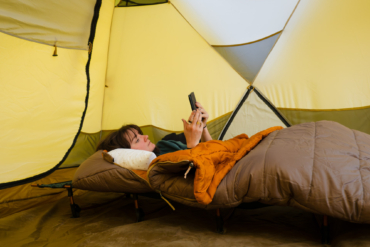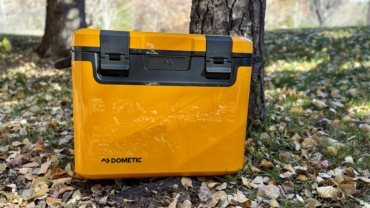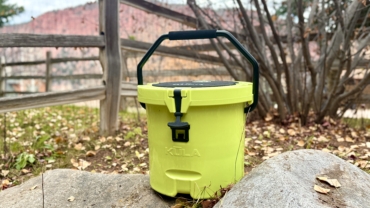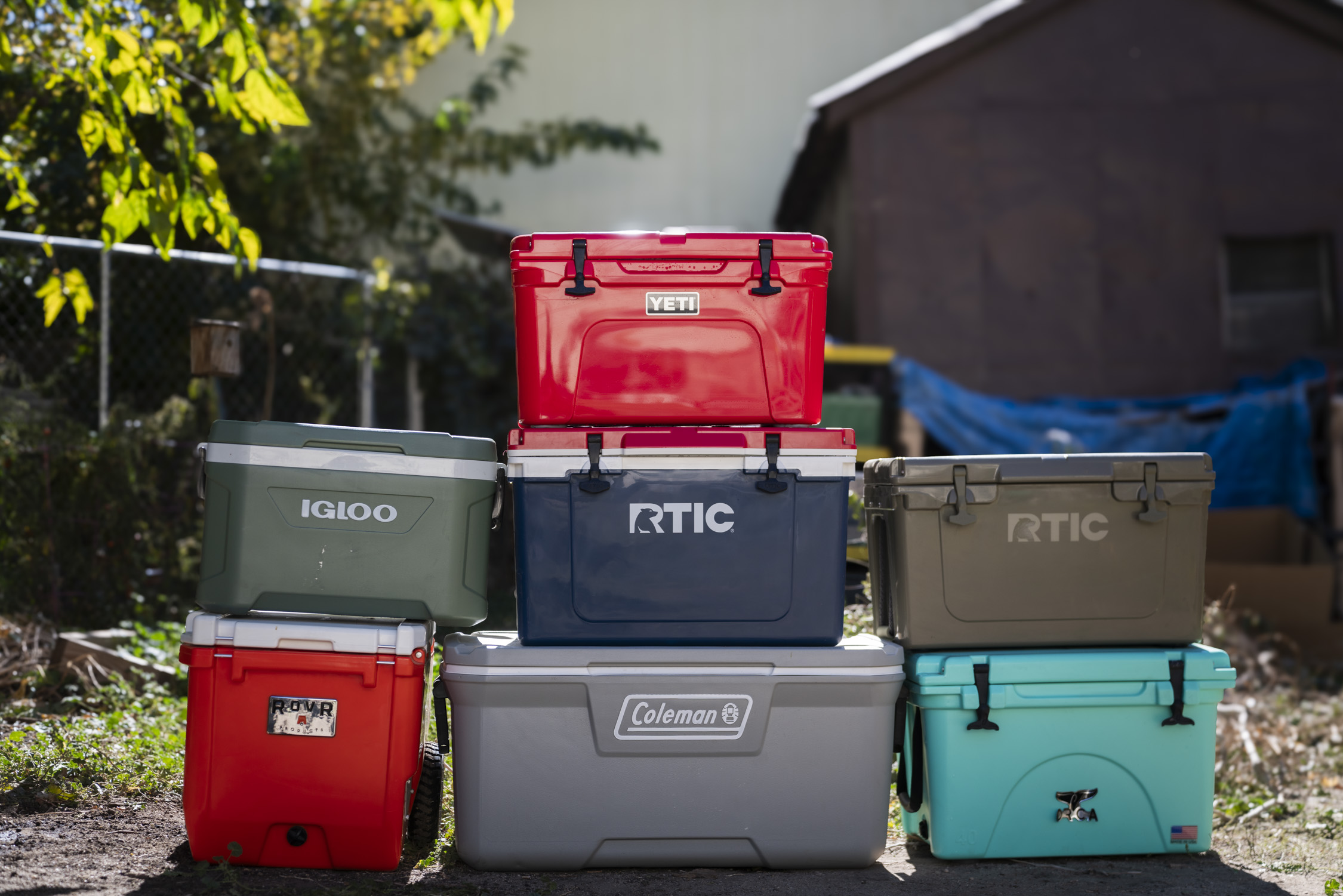What should you bring camping? Our camping checklist has you covered.
If you’re reading this, we’re guessing you have a camping trip soon. So we’ll get right into a checklist that you can use to ensure you leave nothing important behind.
For this list, we’re sticking to the essentials. This is the camp gear you should consider for every camping trip. We included links below you can use to purchase camping essentials.
Camp Sleeping Gear
When it comes to car camping, weight becomes much less of a consideration than in backpacking. So many general camping products, like sleeping pads and sleeping bags, are a lot less expensive than their made-for-backpacking, ultralight alternatives.
And for sleeping pads, this is the place you can go thick and cushy. Even cots are fair game.

However, if you also backpack, you can certainly use your backpacking kit for car camping. Indeed, our editors have spent many years using very nice backpacking sleeping pads and bags in campgrounds because, well, it’s what they own.
Similarly, when you’re camping near your car (or using mechanized or horseback transport), you can use a larger, heavier tent than if you’re backpacking.
Of course, other options, like rooftop tents, RVs, rugged trailers, and pop-ups also come into play here. But for the sake of this article, consider “tent” to be your shelter regardless of what you choose.
Backpacking tents will certainly work for car camping, and many people use light tents for all their shelter needs. However, be aware they are often more fragile than heavier family tents, so consider adding a footprint to help protect it from sharp objects on the ground and pitch it mindfully.
- Sleeping bag
- Sleeping pad
- Tent
- Pillow (optional but highly recommended)
Essential Camp Cooking Kit
Everything tastes better after a day outside. And if you’re car camping, this can be doubly true! With modern equipment, you can bring all the cooking comforts of home to your outdoor kitchen.
Our team loves to get gourmet while camping, and many people love the challenge of cooking amazing meals at the campsite.
Our printable list includes the basics. But we also include links here to some of our favorite upgrades. Things like portable refrigerators have really changed the way people can camp!
But while you can literally bring the kitchen sink, minimal camping is still simple — just a water container, pot, pan, stove, fuel, and implements. A cooler will allow for more fresh foods but isn’t always needed.
- Water storage (a 5-gallon cube is ideal for car camping)
- Stove
- Fuel (make sure it’s the right fuel for your stove!)
- Pot (for boiling water or heating liquids)
- Frying pan (such as cast iron or nonstick)
- Camp coffee maker
- Spatula
- Plates, bowls (one per camper)
- Eating utensils (fork, spork, or spoon; one per camper depending on meals)
- Cooking oil
- Salt, pepper, seasonings
- Cutting board
- Knife
- Bottle opener, can opener, corkscrew
- Dishwashing basin (or plastic bin)
- Biodegradable soap
- Sponge
- Dish towel
- Multiple trash bags (for trash, recycling, compost, etc.)
- Personal water bottle (one for each camper) or water bladder
- Cooler and ice
Electronics
Modern campers have access to more electronic gadgets than ever. Our recommendation? Leave most of them at home.
But you will still want the basics. Make sure to have at minimum a light source and phone charger. And load up useful apps for your phone before going off the grid.
- Headlamp (plus charging cord or rechargeable/extra batteries)
- Flashlight (plus charging cord or rechargeable/extra batteries)
- Camp lighting (lantern, string lights, etc.)
- Cellphone
- Phone charging cord (and plugin)
- Portable battery pack
- Speaker
Camp Comfort
If you’re camping for a few days or weeks, these things will make your time outside a lot more pleasant.
Especially in dispersed sites without tables, camp chairs will make a world of difference. A tarp or sunshade is an excellent addition to summertime campsites. And a hammock, blanket, and games will keep you cozy and entertained.
- Camping chairs
- Tarp or sunshade
- Hammock
- Camp blanket
- Camp games
Fire Tools
Campfires are one of the great joys of nighttime outdoors. And while you certainly don’t always need one (and often they are banned due to drought or sensitive locations), the times you can have a campfire are extra special.
Starting a campfire is generally quite easy with dry wood. There are tons of online resources explaining how to tackle the job.
But in short, start with very small kindling and build a teepee-shaped stack of wood. Place the firestarter under the stack and light it, carefully adding gradually bigger (think pencil-size, then finger- and wrist-size) pieces of wood.
Materials you’ll need are a lighter or matches, firestarter, and wood-cutting tools, plus water for dousing fires.
If you do make a fire, please be careful and be mindful of Leave No Trace ethics.
- Lighter or matches
- Firestarter (old newspaper, commercial firestarters, lighter fluid)
- Axe
- Saw
- Shovel
- Extra water for dousing fires
- Fire extinguisher (for RVs or campers with indoor kitchens)
Remote Camping Gear for Backcountry Camps
Backpacking trips into the wilderness require specialized, and extra, equipment. Please see our backpacking gear checklist here for a complete rundown.
Personal Hygiene and Safety
Everyone’s personal hygiene kit varies a little bit. Some carry nothing more than a toothbrush and toilet paper. Others have an extensive kit that includes all sorts of luxuries. We won’t judge!
But our checklist includes the basics that most people will want to carry, including toilet paper, toothpaste and toothbrush, sunscreen, hand sanitizer and, one of our favorites, a dental floss and needle kit.
- Toilet paper
- Toothbrush and toothpaste
- Sunscreen
- Prescription drugs
- Hand sanitizer
- Menstrual products
- Dental floss and needle kit
- Bug protection
- First-aid kit
- Trowel for digging catholes (if no restrooms available)
Camping Tips
Whether you’re new to camping or simply looking to improve your camp game, here are a few tips for making getting out into the great outdoors fun for everyone.
Get Organized
There’s nothing more annoying than having everything you need to camp but being unable to find key gear. Taking the time to pack in an organized manner will make your outdoor time with family and friends that much more enjoyable.
This is particularly true of your camp kitchen. Having a chuck box — a container that organizes your camp cooking essentials — is endlessly useful. Something like the Camp Chef Sherpa is a great option, as it does double duty as an organizer and table. We’ve also used one of these heavy-duty totes for years now. It’s affordable, durable, and easy to pack.
The bottom line is it pays to plan as you pack. Put your clothes, sleeping gear, and personal items in separate containers so you can find them easily when you arrive at camp. And make sure essentials like a first-aid kit are always readily accessible.
Practice at Home
Anytime you get new gear, it’s best to set it up at home first. There’s nothing more frustrating than fumbling with your tent as the light fades. This is doubly true if you’re camping with children.
Take an evening to learn how to use new gear and make sure that older gear is still in good repair.
Camp Meals
There are a lot of options for camp cooking. You could keep it simple with a canister stove and dehydrated meals. Or go all out with a four-course dinner. We’ve certainly done both and have found that the middle ground tends to be best for car and family tent camping.
Brands like Patagonia even offer full meal kits, including breakfast, lunch, dinner, snacks, and desserts.

When possible, do a little prep beforehand. Chopping veggies and pre-measuring ingredients will make your time camp cooking much more fun. And remember that fewer dishes dirtied means fewer dishes to clean.
Leave No Trace
Whether you’re heading miles into the backcountry or reserving a spot at the local campground, it’s important to pack it out. Bring trash bags so you can easily take out your garbage and recycling. And work to minimize your impact. Brush up on the seven Leave No Trace principles, and you’ll be good to go.
Don’t Forget the First-Aid Kit
Even if you’re planning a simple campground night out, it’s important to have a first-aid kit. Accidents happen when you least expect them, and it pays to be prepared. You can make a first-aid kit or choose from one of Adventure Medical Kits‘ well-organized and easy-to-pack options.











